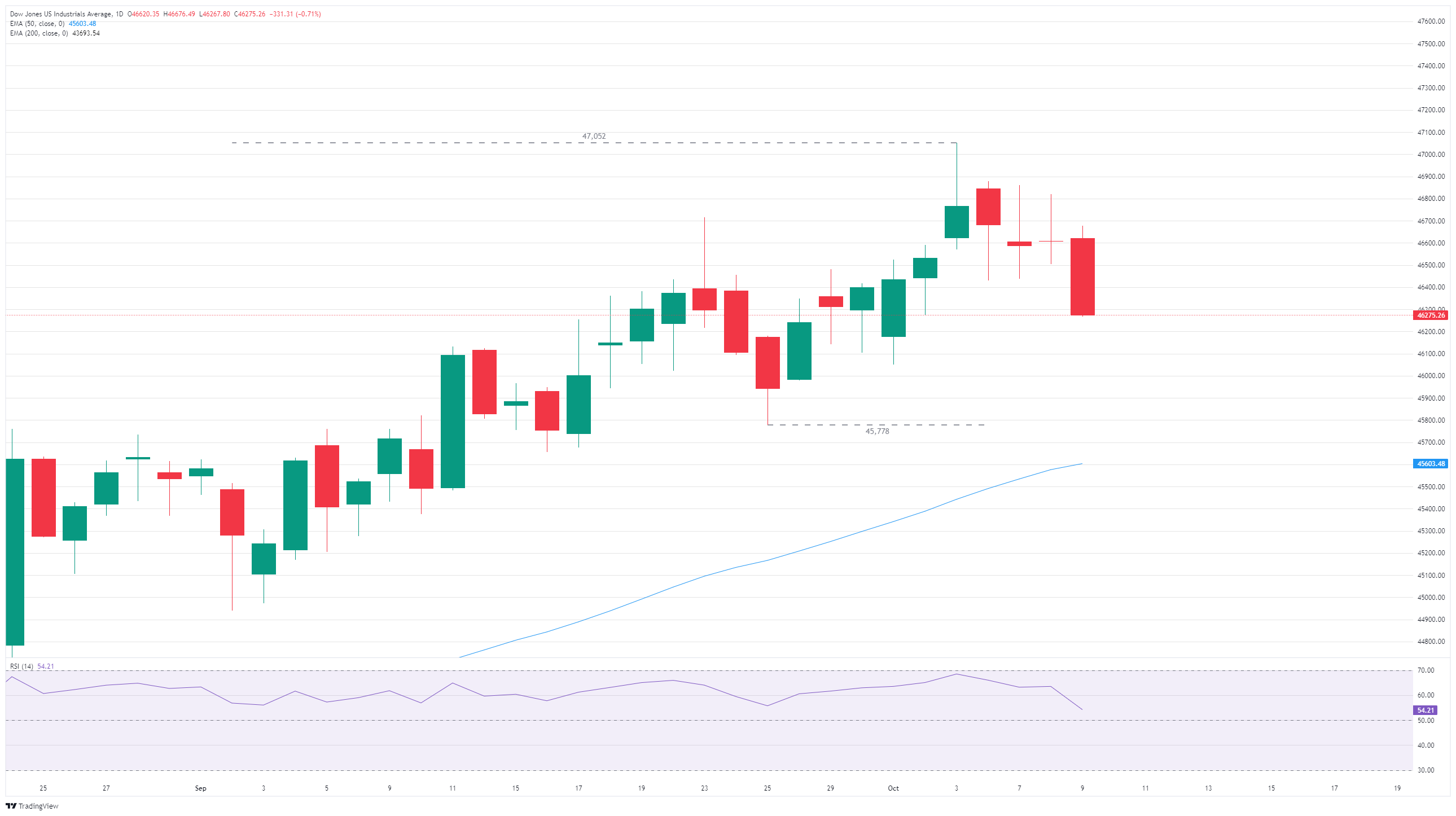Dow Jones Industrial Average retreats as government shutdown continues
- The Dow Jones fell on Thursday, hitting a one-week low.
- Equities are retreating as investors grow more wary about government gridlock.
- The government shutdown has suspended the flow of official data, adding increased focus to private data.
The Dow Jones Industrial Average (DJIA) knocked sharply lower on Thursday following a week-long meandering period. The Dow tumbled into the 46,300 region after opening the American market session near 46,600, knocking the major equity index down around 300 points at the time of writing.
The US government’s ongoing shutdown has officially extended past the one-week mark, reaching its ninth day on Thursday. Investors initially showed little to no reaction to the shuttering of federal services, but market apprehension is slowly on the rise as the US Senate shows no signs of progress. Senate Republicans have rejected multiple budget bridging proposals from Democrats, as the two sides of the US government vote down party lines.
US government tearing itself apart over healthcare
The key hangup between the two sides is national healthcare provisions that are set to expire, which will remove millions of Americans from already-existing care programs. Democrats want a patchwork extension while the Trump administration works on its proposal to replace 'Obamacare', the moniker given to the Affordable Care Act (ACA), crafted and established under President Barack Obama. The Trump team has been promising a total revamping of the ACA since Donald Trump first hit the campaign trail during his first term. Fast forward to today, any semblance of an ACA replacement has yet to see daylight, but Republicans refuse to include any kind of extension to ACA coverage in the current federal budget, stating that they will only discuss it after the budget has been passed.
The government shutdown has also clamped down on the release of official datasets, leaving markets to grapple with newly added emphasis on private datasets. This week’s key release will be the University of Michigan’s (UoM) Consumer Sentiment Index for October, slated for Friday. Aggregated consumer survey results are expected to ease slightly as ongoing trade war headlines and rising inflation pressures eat away at consumer confidence.

Dow Jones daily chart

Dow Jones FAQs
The Dow Jones Industrial Average, one of the oldest stock market indices in the world, is compiled of the 30 most traded stocks in the US. The index is price-weighted rather than weighted by capitalization. It is calculated by summing the prices of the constituent stocks and dividing them by a factor, currently 0.152. The index was founded by Charles Dow, who also founded the Wall Street Journal. In later years it has been criticized for not being broadly representative enough because it only tracks 30 conglomerates, unlike broader indices such as the S&P 500.
Many different factors drive the Dow Jones Industrial Average (DJIA). The aggregate performance of the component companies revealed in quarterly company earnings reports is the main one. US and global macroeconomic data also contributes as it impacts on investor sentiment. The level of interest rates, set by the Federal Reserve (Fed), also influences the DJIA as it affects the cost of credit, on which many corporations are heavily reliant. Therefore, inflation can be a major driver as well as other metrics which impact the Fed decisions.
Dow Theory is a method for identifying the primary trend of the stock market developed by Charles Dow. A key step is to compare the direction of the Dow Jones Industrial Average (DJIA) and the Dow Jones Transportation Average (DJTA) and only follow trends where both are moving in the same direction. Volume is a confirmatory criteria. The theory uses elements of peak and trough analysis. Dow’s theory posits three trend phases: accumulation, when smart money starts buying or selling; public participation, when the wider public joins in; and distribution, when the smart money exits.
There are a number of ways to trade the DJIA. One is to use ETFs which allow investors to trade the DJIA as a single security, rather than having to buy shares in all 30 constituent companies. A leading example is the SPDR Dow Jones Industrial Average ETF (DIA). DJIA futures contracts enable traders to speculate on the future value of the index and Options provide the right, but not the obligation, to buy or sell the index at a predetermined price in the future. Mutual funds enable investors to buy a share of a diversified portfolio of DJIA stocks thus providing exposure to the overall index.

